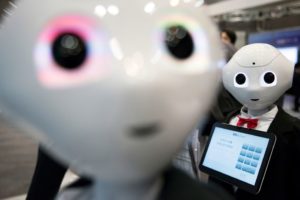
In 1992, Japan’s efforts to overtake the Western world and become the ultimate computer superpower came to a dramatic end. Newspapers were writing about the decadelong project sponsored by the Japanese government, which invested $400 million in an attempt to create the world’s ultimate intelligent machine that combined state of the art hardware with software that would support artificial intelligence applications with “reasoning capabilities.”
The legacy of the so-called Fifth Generation Computer Systems, a government initiative in the 1980s focused on developing a “super computer” that ultimately failed, would deeply scar the Japanese ego. The country’s computer ambitions not only prompted a strong competitive reaction from the West, but also failed to prove that the nation could develop an in-house computer standard that could later be adopted by the world.
Now all those lessons could help Japan regain its world dominance in the age of artificial intelligence, say experts. While Japan failed in its attempt in the 1980s to implement a new technological philosophy, it learned valuable lessons that might now help it regain its place as the new industrial revolution is geared toward AI, a high-end technology that operates more on integration than specialization.
The country’s growing economic pressures at home and abroad today underscore the importance of learning from the past.
When More Became Too Much
Japan’s earlier tech strategy failed because it was primarily geared toward integration – the ability of its companies to produce all major components in-house – while their American competitors were looking at specialization, experts say.
“Japan just completely got that wrong and ‘sort of’ fully integrated production companies just didn’t work because of the complexity of the technology and the need for economies of scale,” says Rob Atkinson, president of the Information Technology and Innovation Foundation. “The U.S. model just worked better.”
The Japanese also focused on building state-of-the-art hardware components, and focused less on software development, Atkinson adds.
“They really didn’t understand the big advantages in software, not hardware,” he says. “You’ve got to be good at hardware, but software really was where it was at, and the U.S. just was better than anybody else on software.”
The fall of the Fifth Generation coincided with a period of economic downturn and the decade that followed is considered a “lost” one by historians.
“The seemingly obvious cause of this prolonged stagnation was the excess capacity built up during the boom years of 1980s and the resulting sharp decline of investments in plants and equipments in the 1990s, which led to a steep decline in asset prices and to loan defaults,” say the authors of the “21st Century Innovation Systems for Japan and the United States” by the National Research Council in Washington, D.C.
The country maintained a global status for fostering innovation, despite being soon overshadowed by the new economic superpower China, which rose to power in the early 2000s, and heavily invested in technology. Its position among the world’s tech leaders fluctuated and Japan claimed 13th spot in the 2018 Global Innovation Index, up one spot from the previous year, while China joined the top 20.
Japan today is now a top global exporter of industrial robots and, according to the International Federation of Robotics, ranks second in the world by sales after China, reporting 45,566 units installed in 2017. Until 2012, Japan was also the largest global robot market by annual supply.
Applying Past Lessons
Since the ’90s, Japan began looking at ways to integrate both the lessons it learned from its previous failure and the practices it saw being implemented abroad in order to develop its software industry. One key element: cooperation.
“(The Japanese) followed the example of (South) Korea in that regard, inviting more foreign companies, and joint ventures, including in areas where they had a strong competitive advantage like the automobile industry, also in aeronautics,” says Bruno Lanvin, executive director of Global Indices at INSEAD and co-editor of the Global Innovation Index. “We’ve seen the performance of Japan increasing in areas that used to be weak points and that are still weak points, but (that) they now want to address.”
Japan has an aging population and shrinking workforce that is forcing the government to implement new measures, including loosening its immigration rules. Japan today is facing pressure from the West, with President Donald Trump targeting its large trade surplus with the U.S. in trade talks this year, a move that will force the East Asian nation to look for new markets and new industries.
The fourth industrial revolution with super-intelligent machines that threatens to displace people at their workplace is now very different from the last one and much more suited for what Japan is good at, experts agree. While the last wave of innovation was centered around computing, software and the internet, the next one promises to be much more about transforming the physical world with technology.
“Things like the industrial internet, using technologies in manufacturing, the internet of things, smart cities, connected vehicles, robotics, autonomous drones – these are all areas where the Japanese have many more core strengths around mechanical and electrical engineering,” Atkinson says. “Now they’re playing on a field that’s a little more friendly to them, while the one in the last 30 years was more a more of a friendly feel to the United States.”
Japan also can become competitive in quantum computing development, a sector that the United States and China lead, while Europe lags far behind, Lanvin says. Japan could ultimately convert even its biggest disadvantage – its aging population – into a win.
“This could be reconciled by innovating in a number of areas that benefit rather than suffer from demography,” Lanvin adds. “In everything linked to agin

